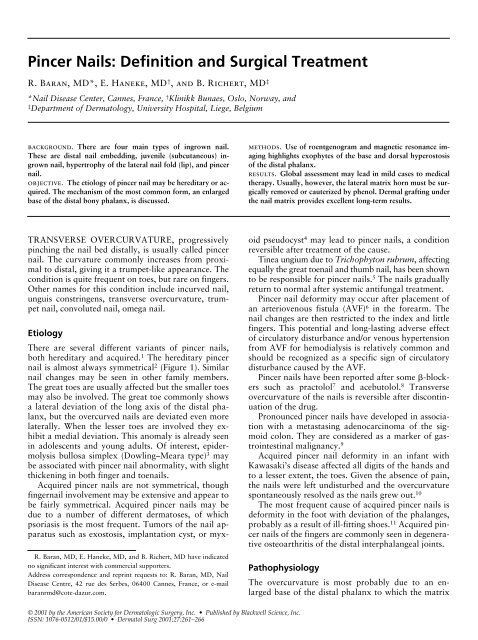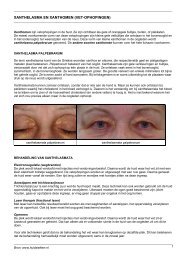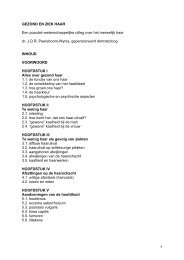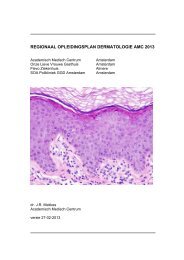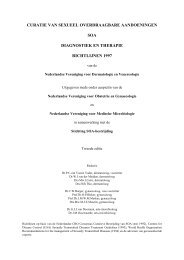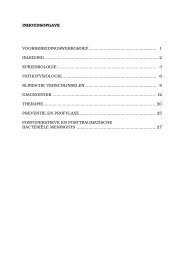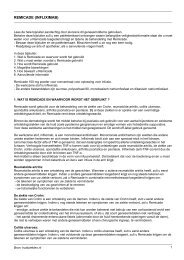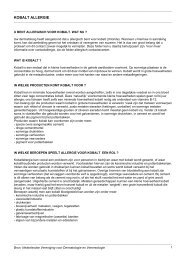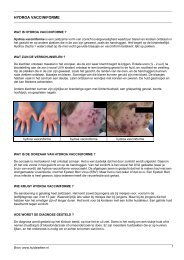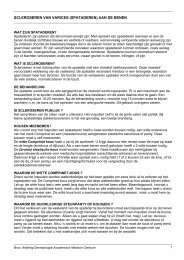Pincer Nails: Definition and Surgical Treatment - Huidziekten.nl
Pincer Nails: Definition and Surgical Treatment - Huidziekten.nl
Pincer Nails: Definition and Surgical Treatment - Huidziekten.nl
Create successful ePaper yourself
Turn your PDF publications into a flip-book with our unique Google optimized e-Paper software.
<strong>Pincer</strong> <strong>Nails</strong>: <strong>Definition</strong> <strong>and</strong> <strong>Surgical</strong> <strong>Treatment</strong><br />
R. Baran, MD*, E. Haneke, MD†<br />
, <strong>and</strong> B. Richert, MD‡<br />
* Nail Disease Center, Cannes, France, † Klinikk Bunaes, Oslo, Norway, <strong>and</strong><br />
‡ Department of Dermatology, University Hospital, Liege, Belgium<br />
background. There are four main types of ingrown nail.<br />
These are distal nail embedding, juvenile (subcutaneous) ingrown<br />
nail, hypertrophy of the lateral nail fold (lip), <strong>and</strong> pincer<br />
nail.<br />
objective. The etiology of pincer nail may be hereditary or acquired.<br />
The mechanism of the most common form, an e<strong>nl</strong>arged<br />
base of the distal bony phalanx, is discussed.<br />
TRANSVERSE OVERCURVATURE, progressively<br />
pinching the nail bed distally, is usually called pincer<br />
nail. The curvature commo<strong>nl</strong>y increases from proximal<br />
to distal, giving it a trumpet-like appearance. The<br />
condition is quite frequent on toes, but rare on fingers.<br />
Other names for this condition include incurved nail,<br />
unguis constringens, transverse overcurvature, trumpet<br />
nail, convoluted nail, omega nail.<br />
Etiology<br />
There are several different variants of pincer nails,<br />
both hereditary <strong>and</strong> acquired. 1 The hereditary pincer<br />
nail is almost always symmetrical2<br />
(Figure 1). Similar<br />
nail changes may be seen in other family members.<br />
The great toes are usually affected but the smaller toes<br />
may also be involved. The great toe commo<strong>nl</strong>y shows<br />
a lateral deviation of the long axis of the distal phalanx,<br />
but the overcurved nails are deviated even more<br />
laterally. When the lesser toes are involved they exhibit<br />
a medial deviation. This anomaly is already seen<br />
in adolescents <strong>and</strong> young adults. Of interest, epidermolysis<br />
bullosa simplex (Dowling–Meara type) 3 may<br />
be associated with pincer nail abnormality, with slight<br />
thickening in both finger <strong>and</strong> toenails.<br />
Acquired pincer nails are not symmetrical, though<br />
fingernail involvement may be extensive <strong>and</strong> appear to<br />
be fairly symmetrical. Acquired pincer nails may be<br />
due to a number of different dermatoses, of which<br />
psoriasis is the most frequent. Tumors of the nail apparatus<br />
such as exostosis, implantation cyst, or myx-<br />
R. Baran, MD, E. Haneke, MD, <strong>and</strong> B. Richert, MD have indicated<br />
no significant interest with commercial supporters.<br />
Address correspondence <strong>and</strong> reprint requests to: R. Baran, MD, Nail<br />
Disease Centre, 42 rue des Serbes, 06400 Cannes, France, or e-mail<br />
baranrmd@cote-dazur.com.<br />
© 2001 by the American Society for Dermatologic Surgery, Inc. • Published by Blackwell Science, Inc.<br />
ISSN: 1076-0512/01/$15.00/0 • Dermatol Surg 2001;27:261–266<br />
methods. Use of roentgenogram <strong>and</strong> magnetic resonance imaging<br />
highlights exophytes of the base <strong>and</strong> dorsal hyperostosis<br />
of the distal phalanx.<br />
results. Global assessment may lead in mild cases to medical<br />
therapy. Usually, however, the lateral matrix horn must be surgically<br />
removed or cauterized by phenol. Dermal grafting under<br />
the nail matrix provides excellent long-term results.<br />
oid pseudocyst4<br />
may lead to pincer nails, a condition<br />
reversible after treatment of the cause.<br />
Tinea ungium due to Trichophyton rubrum,<br />
affecting<br />
equally the great toenail <strong>and</strong> thumb nail, has been shown<br />
to be responsible for pincer nails. 5 The nails gradually<br />
return to normal after systemic antifungal treatment.<br />
<strong>Pincer</strong> nail deformity may occur after placement of<br />
an arteriovenous fistula (AVF)<br />
6<br />
in the forearm. The<br />
nail changes are then restricted to the index <strong>and</strong> little<br />
fingers. This potential <strong>and</strong> long-lasting adverse effect<br />
of circulatory disturbance <strong>and</strong>/or venous hypertension<br />
from AVF for hemodialysis is relatively common <strong>and</strong><br />
should be recognized as a specific sign of circulatory<br />
disturbance caused by the AVF.<br />
<strong>Pincer</strong> nails have been reported after some �-block<br />
ers such as practolol<br />
7<br />
<strong>and</strong> acebutolol.<br />
8<br />
Transverse<br />
overcurvature of the nails is reversible after discontinuation<br />
of the drug.<br />
Pronounced pincer nails have developed in association<br />
with a metastasing adenocarcinoma of the sigmoid<br />
colon. They are considered as a marker of gas-<br />
trointestinal malignancy.<br />
9<br />
Acquired pincer nail deformity in an infant with<br />
Kawasaki’s disease affected all digits of the h<strong>and</strong>s <strong>and</strong><br />
to a lesser extent, the toes. Given the absence of pain,<br />
the nails were left undisturbed <strong>and</strong> the overcurvature<br />
spontaneously resolved as the nails grew out. 10<br />
The most frequent cause of acquired pincer nails is<br />
deformity in the foot with deviation of the phalanges,<br />
probably as a result of ill-fitting shoes.<br />
11<br />
Acquired pin-<br />
cer nails of the fingers are commo<strong>nl</strong>y seen in degenerative<br />
osteoarthritis of the distal interphalangeal joints.<br />
Pathophysiology<br />
The overcurvature is most probably due to an e<strong>nl</strong>arged<br />
base of the distal phalanx to which the matrix
262<br />
baran et al.: pincer nails: definition <strong>and</strong> surgical treatment<br />
Figure 1. Hereditary pincer nails: A) front view, B) symmetrical<br />
dorsal view.<br />
is firmly bound by ligament-like collagen fibers (Figure<br />
2). Since toenails are markedly curved, the curvature<br />
of the proximal (matricial) nail plate portion will<br />
decrease <strong>and</strong> consequently the curvature will increase<br />
distally (Figure 3).<br />
Radiographs <strong>and</strong> magnetic resonance imaging (MRI)<br />
of big toes with pincer nails invariably show an e<strong>nl</strong>argement<br />
of the base of the distal phalanx <strong>and</strong> often<br />
hooklike lateral osteophytes pointing distally (Figure<br />
4A). This is virtually always more pronounced on the<br />
medial aspect, explaining why the nail’s longitudinal<br />
axis is deviated more laterally than that of the distal<br />
phalanx. The distally more pronounced overcurvature<br />
exerts traction on the nail bed which is transduced to<br />
the bone by the ligament-like fibers fixing the solehorn<br />
to the tip of the terminal phalanx. This eventually results<br />
in a traction osteophyte which is also often seen<br />
on radiographs1,12<br />
<strong>and</strong> MRI (Figure 4B).<br />
Signs <strong>and</strong> Symptoms<br />
The toenails present a physiologically transverse convexity<br />
that is more pronounced than in the fingernails.<br />
When this transverse curvature becomes exaggerated,<br />
Dermatol Surg 27:3:March 2001<br />
Figure 2. E<strong>nl</strong>arged base of the distal phalanx in pincer nail.<br />
the lateral nail plate edges dig into the lateral grooves<br />
<strong>and</strong> upon further incurving start to pinch the nail bed<br />
(Figure 5). After a while, the soft tissue may actually<br />
disappear <strong>and</strong> may even be accompanied by resorp-<br />
tion of the underlying bone.<br />
Morphologically there are three clinical types: the<br />
“common” pincer nail (trumpet nail deformity), the<br />
tile-shaped nail, <strong>and</strong> the plicated nail. The most frequently<br />
seen type is the trumpet nail deformity with<br />
the overcurvature increasing along the axis from prox-<br />
imal to distal.<br />
14<br />
13<br />
The lateral plate margins virtually roll<br />
in, sometimes even forming a tube (Figure 6). The nail<br />
bed becomes pinched, shrinks in its transverse diameter,<br />
<strong>and</strong> is lifted up distally by the continuous traction<br />
exerted on the distal dorsal tuft. The lateral plate margins<br />
may eventually break through the epidermis <strong>and</strong><br />
produce granulation tissue mimicking an ingrown toenail.<br />
Cutting the nail may become more <strong>and</strong> more difficult<br />
<strong>and</strong> painful with increasing overcurvature; furthermore<br />
this is frequently associated with thickening<br />
of the nail plate. To enhance the cosmetic appearance,<br />
patients <strong>and</strong> podiatrists tend to round the distal margin<br />
of the overcurved nail plate; this reduces pressure<br />
on the most distal portion of the lateral nail grooves,<br />
Figure 3. The curvature of the proximal nail plate segment decreases<br />
<strong>and</strong> consequently increases distally.
Dermatol Surg 27:3:March 2001<br />
Figure 4. MRI showing A) lateral osteophyte at the base of the<br />
phalanx <strong>and</strong> B) distal traction osteophyte.<br />
however, there is a great risk of leaving a nail spike<br />
which inevitably will pierce into the soft tissue.<br />
Pachyonychia congenita may mimick pincer nails, but<br />
it is usually not painful <strong>and</strong> involves both finger <strong>and</strong> toenails.<br />
Pain is not a consistent symptom of pincer nails.<br />
Some extreme cases are completely pai<strong>nl</strong>ess, whereas<br />
sometimes even mild cases may cause excruciating pain,<br />
provoked by no more than the weight of a bed sheet. 14<br />
Figure 5. <strong>Pincer</strong> nail, a moderate case.<br />
baran et al.: pincer nails: definition <strong>and</strong> surgical treatment<br />
Figure 6. Trumpet nail.<br />
263<br />
Tile-shaped nails are characterized by an even,<br />
transverse overcurvature with the lateral nail edges remaining<br />
parallel. This type is usually less severe, does<br />
not cause serious symptoms, <strong>and</strong> is frequently seen in<br />
tall young people with the “unguis incarnatus syn-<br />
drome”<br />
15<br />
or in fingernail overcurvature.<br />
The plicated nail presents a moderate convexity<br />
with one (Figure 7) or both lateral plate edges being<br />
sharply bent to form a vertical sheet pressing into the<br />
lateral nail groove. Bilateral symmetrical involvement<br />
of the nails is mai<strong>nl</strong>y seen on fingers, but unilateral angling<br />
of a nail is common in foot deformities.<br />
Indications for <strong>Treatment</strong><br />
The major indications for treatment are pain <strong>and</strong> inflammation.<br />
Other indications are interference with<br />
wearing shoes <strong>and</strong> cosmetic embarrassment. Therapeutic<br />
approaches vary according to the severity <strong>and</strong><br />
Figure 7. A) Unilateral nail plication. B) After surgical excision of<br />
the lateral matrix horn.
264<br />
baran et al.: pincer nails: definition <strong>and</strong> surgical treatment<br />
type of overcurvature, possible risk factors, previous<br />
unsuccessful treatment, <strong>and</strong> a multitude of personal<br />
<strong>and</strong> psychological preferences of both the treating<br />
physician <strong>and</strong> patient.<br />
Conservative <strong>Treatment</strong><br />
Most patients consulting a physician have already<br />
tried some conservative treatment. Usually they try to<br />
clip down the lateral edge of the incurved nail as far as<br />
possible proximally <strong>and</strong> they o<strong>nl</strong>y stop when they cut<br />
into the skin of the lateral nail groove. Since the nail is<br />
frequently thick <strong>and</strong> hard, it should first be softened<br />
using an emollient under occlusion for some days or a<br />
10-minute hot foot bath prior to nail clipping.<br />
In early overcurvature, thinning of the central portion<br />
of the nail plate from the lunula to the free margin<br />
may alleviate the pain, since this technique increases<br />
the nail plate’s pliability. A single groove or a<br />
series of grooves may be cut into the nail plate surface<br />
using a burr, or the entire nail plate is ground to thin<br />
it. Recently the use of 40% urea paste <strong>and</strong> subsequent<br />
removal of the softened nail material, performed regularly<br />
over a period of 1 year, was shown to normalize<br />
hereditary pincer nails in a 38-year-old woman. 16<br />
There are several alternative methods for mechanical<br />
correction of malformed nails, called orthonyx.<br />
17–19<br />
The principle is to exert tension on the transverse nail<br />
curvature in order to gradually flatten the plate. After<br />
cleaning the lateral nail grooves, a stai<strong>nl</strong>ess steel brace<br />
is inserted on the nail plate <strong>and</strong> fixed under the lateral<br />
edges. An adjustment is made to the brace in order to<br />
exert countertension on the plate, <strong>and</strong> with a series of<br />
adjustments the nail plate gradually flattens over a period<br />
of 6 or more months. We have obtained good responses<br />
in treating fingernail overcurvature associated<br />
with osteoarthritis; however, immediate relapse was<br />
observed after orthonyx treatment. More recently,<br />
elastic plastic braces glued to the abraded nail surface<br />
were successfully used by Effendy et al.<br />
Conservative treatment always appears to be tempting<br />
to patients. However, no publication recommending<br />
clipping, grooving, thinning, <strong>and</strong> orthonyx with<br />
steel or plastic braces has mentioned the bone alterations<br />
seen in nearly all patients on X-ray films. The<br />
patients we saw all experienced recurrences, usually in<br />
o<strong>nl</strong>y about half the time needed to correct the pincer<br />
nail. We therefore believe that conservative treatment<br />
of pincer nails gives o<strong>nl</strong>y some temporary relief.<br />
<strong>Surgical</strong> <strong>Treatment</strong><br />
Repeated nail avulsions21<br />
were thought to permit the<br />
pinched nail bed tissue to flatten spontaneously during<br />
the period of nail plate regrowth. However, many pa-<br />
20<br />
Dermatol Surg 27:3:March 2001<br />
tients experience a dramatic worsening of their condition<br />
after nail avulsion, <strong>and</strong> it has been found that<br />
there is rarely any benefit from this procedure. Furthermore,<br />
nail avulsion is known to increase the phys-<br />
iological transverse curvature of normal hallux nails.<br />
22,23<br />
There is a technique aimed at correcting the firm<br />
swelling of the distal nail bed. The nail bed is cut by a<br />
median longitudinal incision <strong>and</strong> the soft tissues are<br />
dissected from the terminal phalanx. Reversed tie-over<br />
sutures are put in the lateral nail folds <strong>and</strong> tied over a<br />
pad on the plantar aspect of the toe in order to spread<br />
the nail bed. The resulting triangular defect is covered<br />
with a free skin graft. The stitches are removed after<br />
about 3 weeks. An onycholytic area will develop cor-<br />
responding to the size of the free graft.<br />
24<br />
This tech-<br />
nique was slightly modified by primarily suturing the<br />
nail bed <strong>and</strong> inserting a small plastic plate between the<br />
curved nail plate <strong>and</strong> the flattened resutured nail<br />
bed, 12 however, the result was not permanent.<br />
In fact, these surgical techniques do not take into<br />
account the underlying bone alterations which cause<br />
the overcurvature. Except for permanent nail eradication<br />
by surgical nail ablation or phenolization, relapses are frequent.<br />
Judged from the presumed pathogenesis of pincer<br />
nails, it was felt that either the lateral osteophytes or<br />
the matrix horns which are pushed outward <strong>and</strong> forward<br />
by these bony excrescences would have to be removed.<br />
Removal of the lateral osteophytes is the procedure<br />
thought to offer the best chance of flattering<br />
the nail bed, but it would result in damage to the lateral<br />
ligaments of the distal interphalangeal joint. Therefore<br />
the permanent removal of the lateral matrix horns<br />
was considered to be the simplest, least painful, but<br />
nevertheless a sufficiently effective treatment modality.<br />
(Figure 8). In some cases it may be supplemented<br />
by laterally exp<strong>and</strong>ing the pinched nail bed <strong>and</strong> cutting<br />
the distal dorsal bony tuft, if this abnormality is<br />
prominent <strong>and</strong> associated with pain in the tissue, just<br />
beneath the midportion of the distal nail plate.<br />
14<br />
1,12,25–27<br />
Under regional block anesthesia, lateral nail strips<br />
of the entire nail plate are avulsed. The digit is exsanguinated<br />
<strong>and</strong> the matrix horns are dried <strong>and</strong> either<br />
carefully dissected <strong>and</strong> removed, or phenolized by vigorously<br />
rubbing in liquefied (90%) phenol for 3 minutes.<br />
Small antibiotic tablets are inserted into the<br />
wound cavities. In Haneke’s technique (Figure 9) this<br />
treatment is followed by a median incision of the nail<br />
bed from the lunula border to 2 mm beyond the hyponychium<br />
<strong>and</strong> carried down to the bone. During this<br />
incision, the traction osteophyte is felt with the scalpel<br />
even when it was not obvious on the roentgenogram.<br />
The pinched nail bed is then dissected from the terminal<br />
phalanx, the distal dosal tuft with the osteophyte<br />
is rongeured off, <strong>and</strong> the nail bed is exp<strong>and</strong>ed <strong>and</strong> su-
Dermatol Surg 27:3:March 2001<br />
Figure 9. Haneke’s procedure. A) The nail plate (1) is shortened,<br />
showing the pinched nail bed (2). Bilateral cautery of the lateral matrix<br />
horns (3) will narrow the nail plate. A longitudinal median incision<br />
in the nail bed is carried down to the bone. B) The dorsal tuft of<br />
the phalanx is removed with a bone rongeur. The nail bed is sutured<br />
<strong>and</strong> then exp<strong>and</strong>ed using reversed tie-over sutures placed in the<br />
folds <strong>and</strong> tied over the plantar aspect of the toe. A frontal view C)<br />
before <strong>and</strong> D) after treatment. Replacing the original nail with a donor<br />
“nail bank transplant” will avoid keratinization of the nail bed.<br />
baran et al.: pincer nails: definition <strong>and</strong> surgical treatment<br />
265<br />
tured using 6-0 monofil absorbable sutures (PDS II).<br />
Reverse tie-over sutures are placed in the lateral nail<br />
folds, with small rubber tubes being used as a cushion<br />
to prevent the sutures from cutting through the nail<br />
folds. These sutures keep the nail bed stretched over<br />
the bone <strong>and</strong> are removed after about 3 weeks. In more<br />
than 50 patients, a success rate of more than 80% was<br />
achieved with this technique.<br />
Zook’s team<br />
28,29<br />
has suggested another effective pro-<br />
cedure which may offer the best chance of flattening the<br />
nail bed. It is important not o<strong>nl</strong>y to flatten the sterile<br />
matrix (nail bed) but also to flatten the lateral portions<br />
of the germinal matrix. Uniformly good results<br />
were obtained with this in relief of pain <strong>and</strong> improvement<br />
of appearance.<br />
In his technique, successful treatment of pincer nail<br />
involves removing the tubed nail to visualize the nail<br />
bed. The paronychium is freed from the periosteum of<br />
the distal phalanx through an incision on the tip at the<br />
distal end of the paronychium. Fine scissors are used to<br />
free the paronychium from the periosteum proximally<br />
to beyond the nail fold, allowing the nail bed to flatten.<br />
A strip of dermis of adequate volume (at least 1 cm in<br />
width) is then pulled beneath the paronychium.<br />
In conclusion, mild cases of pincer nail may sometimes<br />
benefit from conservative treatment, but usually<br />
chemical or surgical removal of the lateral matrix<br />
horns, or dermal grafting under the nail matrix provide<br />
excellent long-term treatment.<br />
References<br />
Figure 8. A) <strong>Pincer</strong> nail of a thumb before<br />
treatment. B) The same digit after phenol cautery<br />
of the lateral matrix horns.<br />
1. Haneke E. Etiopathogénie et traitement de l’hypercourbure transversale<br />
de l’ongle du gros orteil. J Méd Esthét 1992;19:123–7.<br />
2. Chapman RS. Overcurvature of the nails—an inherited disorder. Br<br />
J Dermatol 1973;89:317–8.<br />
3. Kitajima Y, Jokura Y, Yaoita H. Epidermolysis bullosa simplex,
266<br />
baran et al.: pincer nails: definition <strong>and</strong> surgical treatment<br />
Dowling–Meara type. A report of two cases with different types of<br />
tonofilament clumping. Br J Dermatol 1993;128:79–85.<br />
4. Baran R, Broutard JC. Epidermoid cyst of the thumb presenting as<br />
pincer nail. J Am Acad Dermatol 1988;19:143–4.<br />
5. Higashi N. <strong>Pincer</strong> nail due to tinea unguium. Hifu 1990;32:40–44.<br />
6. Hwang SM, Lee SH, Ahn SK. <strong>Pincer</strong> nail deformity <strong>and</strong> pseudo-<br />
Kaposi’s sarcoma: complications of an artificial arteriovenous fistula<br />
for haemodialysis. Br J Dermatol 1999;141:1129–32.<br />
7. Bureau H, Baran R, Haneke E. Nail surgery <strong>and</strong> traumatic abnormalities.<br />
In: Baran R, Dawber RPR, eds. Diseases of the nails <strong>and</strong><br />
their management. Oxford: Blackwell, 1984:347–402.<br />
8. Greiner D, Schöfer H, Milbradt R. Reversible transverse overcurvature<br />
of the nails (pincer nails) after treatment with a �-blocker.<br />
J Am Acad Dermatol 1998;39:486–7.<br />
9. Jemec GBE, Thomsen K. <strong>Pincer</strong> nails <strong>and</strong> alopecia as markers of<br />
gastrointestinal malignancy. J Dermatol 1997;24:479–81.<br />
10. V<strong>and</strong>erhooft SL, V<strong>and</strong>erhooft JE. <strong>Pincer</strong> nail deformity after<br />
Kawasaki’s disease. J Am Acad Dermatol 1999;41:341–2.<br />
11. Baran R, Dawber RPR, Tosti A, Haneke E. A text atlas of nail disorders.<br />
London: Martin Dunitz, 1996:29.<br />
12. Haneke E. Segmentale Matrixverschmälerung zur Beh<strong>and</strong>lung des<br />
eingewachsenen Zehennagels. Dtsch Med Wochenschr 1984;109:<br />
1451–3.<br />
13. Cornelius CE, Shelly WB. <strong>Pincer</strong> nail syndrome. Arch Surg 1968;<br />
96:321–2.<br />
14. Baran R. <strong>Pincer</strong> <strong>and</strong> trumpet nails. Arch Dermatol 1974;110:639–40.<br />
15. Steigleder GK, Stober-Münster J. Das Syndrom des eingewachsenen<br />
Nagels. Z Hautkr 1977;52:1225.<br />
16. El-Gammal S, Altmeyer P. Erfolgreiche konservative Therapie des<br />
<strong>Pincer</strong>-Nail-Syndroms. Hautarzt 1993;44:535–7.<br />
Dermatol Surg 27:3:March 2001<br />
17. Fraser AR. Orthonyx: theory <strong>and</strong> practice. Br J Chirop 1967;32:<br />
229–32.<br />
18. Farnsworth FC. A treatment for convoluted nails. J Am Podiatr Assoc<br />
1972;62:110.<br />
19. Dagnall JC. The development of nail treatments. Br J Chirop 1976;<br />
41:165–8.<br />
20. Effendy I, Ossowski B, Happle R. Zangennagel. Konservative Korrektur<br />
durch Aufkleben einer Kunststoffspange. Hautarzt 1993;44:<br />
800–2.<br />
21. Zaias N. The nail in health <strong>and</strong> disease. Jamaica, NY: Spectrum,<br />
1980:171.<br />
22. Haneke E, Baran R, Bureau H. Chirurgie der Nagelregion. Z Hautkr<br />
1982;57:1107–16.<br />
23. Runne U. Operative Eingriffe am Nagelorgan. Z Hautkr 1983;58:<br />
324–32.<br />
24. Suzuki K, Yangi I, Kondo M. <strong>Surgical</strong> treatment of pincer nail syndrome.<br />
Plast Reconstr Surg 1979;63:570–3.<br />
25. Baran R, Haneke E. Nail surgery. In: Epstein E, Epstein E Jr, eds.<br />
Skin surgery, 6th ed. Philadelphia: WB Saunders, 1987:534–47.<br />
26. Haneke E, Baran R. <strong>Nails</strong>: surgical aspects. In: Parish LC, Lask GP,<br />
eds. Aesthetic dermatology. New York: McGraw Hill, 1991:236–47.<br />
27. Douglass MC, Krull EE. Diseases of the nail. In: Rakel R, ed.<br />
Conn’s current therapy. Philadelphia: WB Saunders, 1981:712–8.<br />
28. Brown RE, Zook EG, Williams J. Correction of pincer-nail deformity<br />
using dermal grafting. Plast Reconstr Surg 2000;105:<br />
1658–61.<br />
29. Zook EG, Baran R, Haneke E, Dawber RPR. <strong>Nails</strong> surgery <strong>and</strong><br />
traumatic abnormalities. In: Baran R, Dawber RPR, DeBerker D,<br />
Haneke E, Tosti A, eds. Nail diseases <strong>and</strong> their management, 3rd<br />
ed. Oxford: Blackwell, 2001.


